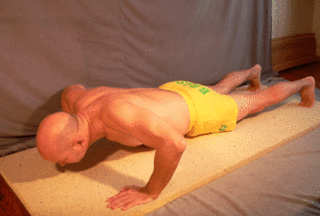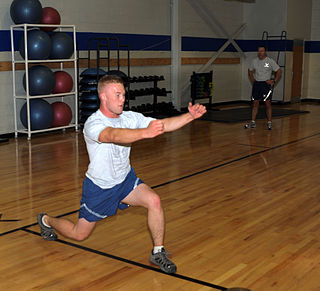
Calisthenics or callisthenics (/ˌkælɪsˈθɛnɪks/) is a form of strength training consisting of a variety of movements that exercise large muscle groups, such as standing, grasping, pushing, etc. These exercises are often performed rhythmically and with minimal equipment, as bodyweight exercises.

The gluteus maximus is the main extensor muscle of the hip in humans. It is the largest and outermost of the three gluteal muscles and makes up a large part of the shape and appearance of each side of the hips. It is the single largest muscle in the human body. Its thick fleshy mass, in a quadrilateral shape, forms the prominence of the buttocks. The other gluteal muscles are the medius and minimus, and sometimes informally these are collectively referred to as the glutes.

The bench press, or chest press, is a weight training exercise where a person presses a weight upwards while lying horizontally on a weight training bench. Although the bench press is a full-body exercise, the muscles primarily used are the pectoralis major, the anterior deltoids, and the triceps, among other stabilizing muscles. A barbell is generally used to hold the weight, but a pair of dumbbells can also be used.

The push-up is a common calisthenics exercise beginning from the prone position. By raising and lowering the body using the arms, push-ups exercise the pectoral muscles, triceps, and anterior deltoids, with ancillary benefits to the rest of the deltoids, serratus anterior, coracobrachialis and the midsection as a whole. Push-ups are a basic exercise used in civilian athletic training or physical education and commonly in military physical training. They are also a common form of punishment used in the military, school sport, and some martial arts disciplines. Variations of push-ups, such as wide-arm push-ups, diamond push-ups target specific muscle groups and provide further challenges.

A squat is a strength exercise in which the trainee lowers their hips from a standing position and then stands back up. During the descent, the hip and knee joints flex while the ankle joint dorsiflexes; conversely the hip and knee joints extend and the ankle joint plantarflexes when standing up. Squats also help the hip muscles.

The deadlift is a weight training exercise in which a loaded barbell or bar is lifted off the ground to the level of the hips, torso perpendicular to the floor, before being placed back on the ground. It is one of the three powerlifting exercises, along with the squat and bench press.

A weight training bench is a piece of exercise equipment used for weight training. Weight training benches may be of various designs: fixed horizontal, fixed inclined, fixed in a folded position, with one adjustable portion, with two or more adjustable portions, with racks to hold bars, etc. In the limit, the definition of a bench blurs into that of combinations that mix a bench and associated equipment.
The good-morning is a weight training exercise. It is known as a good morning because of the movement in the erector spinae which resembles the bow that traditionally begins a schoolday in some East-Asian countries. The erector spinae muscles of the lower back work isometrically to keep the spine in an extended position while the hamstrings and gluteus maximus work isotonically to perform hip extension. Other muscles are involved in stabilizing weight on the back and maintaining balance.

The gluteal muscles, often called glutes, are a group of three muscles which make up the gluteal region commonly known as the buttocks: the gluteus maximus, gluteus medius and gluteus minimus. The three muscles originate from the ilium and sacrum and insert on the femur. The functions of the muscles include extension, abduction, external rotation, and internal rotation of the hip joint.

A lunge can refer to any position of the human body where one leg is positioned forward with knee bent and foot flat on the ground while the other leg is positioned behind. It is used by athletes in cross-training for sports, by weight-trainers as a fitness exercise, and by practitioners of yoga as part of an asana regimen.
A weight machine is an exercise machine used for weight training that uses gravity as the primary source of resistance and a combination of simple machines to convey that resistance to the person using the machine. Each of the simple machines changes the mechanical advantage of the overall machine relative to the weight.

The pull-down exercise is a strength training exercise designed to develop the latissimus dorsi muscle. It performs the functions of downward rotation and depression of the scapulae combined with adduction and extension of the shoulder joint.

The following outline is provided as an overview of and topical guide to exercise:

The leg extension is a resistance weight training exercise that targets the quadriceps muscle in the legs. The exercise is done using a machine called the Leg Extension Machine. There are various manufacturers of these machines and each one is slightly different. Most gym and weight rooms will have the machine in their facility. The leg extension is an isolated exercise targeting one specific muscle group, the quadriceps. It should not be considered as a total leg workout, such as the squat or deadlift.

A fly or flye is a strength training exercise in which the hand and arm move through an arc while the elbow is kept at a constant angle. Flies are used to work the muscles of the upper body. Because these exercises use the arms as levers at their longest possible length, the amount of weight that can be moved is significantly less than equivalent press exercises for the same muscles . Due to this leverage, fly exercises of all types have a large potential to damage the shoulder joint and its associated ligaments and the tendons of the muscles connecting to it. They should be done with caution and their effects first tested while using very light weights; which are gradually incremented after more strength is gained.

The Roman chair is a piece of exercise equipment. The equipment is mainly used for the lower back, but can also target the gluteal muscles, hamstring, and abdominal. The definition of the equipment, and what 'Roman chair exercise' specifically means, is not clear.
Calf raises are a method of exercising the triceps surae, tibialis posterior, and peroneal muscles of the lower leg. The movement performed is plantar flexion, also called ankle extension.

The leg raise is a strength training exercise which targets the iliopsoas. Because the abdominal muscles are used isometrically to stabilize the body during the motion, leg raises are also often used to strengthen the rectus abdominis muscle and the internal and external oblique muscles.

Unilateral training involves the performance of physical exercises using one limb instead of two. Such exercises should be considered as being distinct from bilateral, two limbed, exercises. For example, unilateral squats use one leg, and bilateral squats use two legs. A unilateral bench press uses one arm and a bilateral bench press two arms. Depending on the exercise, this may also entail using different equipment i.e. a dumbbell instead of a barbell. Unilateral exercise is commonly involved in comprehensive training regimes and especially those of professional sports people and athletes. Usually it is used in addition to bilateral training as opposed to instead of it. Unilateral training can yield numerous benefits including improving a person's muscle balance between the left and right sides of their body, improving their sense of balance, and helping to avoid or rehabilitate injury.

















